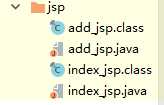标签:合并 odi 分享 strong 加法 请求转发 close style alt
使用方法
标准标签在jsp页面直接编写即可,因为标准标签是JSP规范提供的,所有容器都支持。
被替代性
标准标签的许多功能都可以被JSTL与EL表达式语言所替代。
作用
标准标签可协助编写JSP时减少Scriptlet的使用。
语法
所有标准标签都使用jsp:作为前置。
标准标签<jsp:include>
和include指示元素对比:
include指示元素,可以在JSP转译为Servlet时,将另一个JSP包括进来进行转译,这是静态地包括另一个JSP页面,也就是被包括的JSP与原JSP合并在一起,转译为一个Servlet类,你无法在运行时依条件动态地调整想要包括的JSP页面。
<jsp:include>标签可以在运行时,依条件动态地调整想要包括的JSP页面,当前jsp会生成一个Servlet类,被包含的jsp也会生成一个Servlet类。
Demo
index.jsp
在index.jsp中使用了<jsp:param>标签,指定了传递给add.jsp的请求参数。

<%@page contentType="text/html" pageEncoding="UTF-8" %>
<jsp:include page="add.jsp">
<jsp:param name="a" value="1"/>
<jsp:param name="b" value="2"/>
</jsp:include>
<!DOCTYPE html>
<html>
<head>
<meta charset="UTF-8">
<title>Hello</title>
</head>
<body>
</body>
</html>
add.jsp

<%@page contentType="text/html" pageEncoding="UTF-8" isErrorPage="true" %> <%@page import="java.io.PrintWriter" %> <!DOCTYPE html> <html> <head> <meta charset="UTF-8"> <title>加法网页</title> </head> <body> <% String a = request.getParameter("a"); String b = request.getParameter("b"); %> <p>a + b = <%=a + b %></p> </body> </html>
测试地址:http://127.0.0.1/index.jsp
响应结果:a + b = 12
查看转译后的servlet

查看index_jsp.java的源码有如下代码:

org.apache.jasper.runtime.JspRuntimeLibrary.include( request, response, "add.jsp" + "?" + org.apache.jasper.runtime.JspRuntimeLibrary.URLEncode("a", request.getCharacterEncoding()) + "=" + org.apache.jasper.runtime.JspRuntimeLibrary.URLEncode("1", request.getCharacterEncoding()) + "&" + org.apache.jasper.runtime.JspRuntimeLibrary.URLEncode("b", request.getCharacterEncoding()) + "=" + org.apache.jasper.runtime.JspRuntimeLibrary.URLEncode("2", request.getCharacterEncoding()), out, false);
上面的源码其实就是取得RequestDispatcher对象,并执行include()方法。
<jsp:forward>标签
将请求转发给另一个JSP处理。
同样地,当前页面会生成一个Servlet,而被转发的add.jsp也会生成一个Servlet。
只要把上面index.jsp里的include改为forward即可。
查看index_jsp.java的源码有如下代码:

if (true) { _jspx_page_context.forward("add.jsp" + "?" + org.apache.jasper.runtime.JspRuntimeLibrary.URLEncode("a", request.getCharacterEncoding())+ "=" + org.apache.jasper.runtime.JspRuntimeLibrary.URLEncode("1", request.getCharacterEncoding()) + "&" + org.apache.jasper.runtime.JspRuntimeLibrary.URLEncode("b", request.getCharacterEncoding())+ "=" + org.apache.jasper.runtime.JspRuntimeLibrary.URLEncode("2", request.getCharacterEncoding())); return; }
这里的源码其实就是取得RequestDispatcher对象,并执行forward()方法。
pageContext隐式对象具有forward()与include()方法。
标准标签、<jsp:include>、<jsp:forward>
标签:合并 odi 分享 strong 加法 请求转发 close style alt
原文地址:https://www.cnblogs.com/Mike_Chang/p/10082387.html